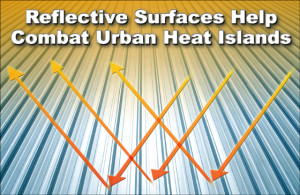Beating City Summer Heat with Reflective Surfaces
Our last blog stressed the importance of greenspaces in mitigating urban heat island (UHI) impacts. Another strategy for diminishing the sweltering heat of UHIs involves lighter, more reflective surfaces on buildings, pavements, and roadways.
Starting at the Top with Roofing Choices
 Roofs account for 20% to 25% of the land cover in cities.
Roofs account for 20% to 25% of the land cover in cities.
The simplest way to cool down hot roofs is to choose light-colored roofing materials. Light colors reflect radiated heat; dark colors absorb heat. The darker the material, the hotter its surface will be on a sultry summer day. Regardless of the roofing material used, a lighter color produces a cooler roof.
On a moderate sunny day with an air temperature of 90°F, a white roof reaches a surface temperature of about 110°F. Surface temperatures on a black roof can soar to 190°F or more.
Light-colored roofing lasts longer than dark roofing, too, reaping another environmental and economical plus.
Beating UHI Heat with Cool-Coated Roofing
Traditional roofing materials absorb 85% to 95% of the sun’s energy. New technologies have yielded highly reflective paints that absorb as little as 35% of the solar energy hitting their surface.
Highly reflective cool-coated roofing materials deflect the sun’s heat away from a building. In fact, cool roofing reflects more of the sun’s energy than any other building product. A roof with high solar reflectance reduces the roof’s surface temperature by as much as 50°F to 60°F on a blistering summer day.
Cool roofing allows less heat to transfer to the building, decreasing the energy needed for air conditioning. Diminished air conditioning usage prolongs the life of the AC unit.
Shrinking energy usage relieves the pressure on the power grid— and lightens the financial strain of those shocking summer utility bills.
Not only does reflection keep the structure cooler in an urban heat island, but the cooler temperatures around the building actually help to reduce smog levels.
In an intensely hot climate like Phoenix, AZ, experts estimate cool roofing may cut utilities by $18 per square foot per year. Even milder climates may save $5 per square foot per year.
In Georgia, a study compared two identical 90,000 square foot school buildings— one with a conventional standing seam green metal roof and the other with a green cool steel roof. The cool roof yielded $8,800 in energy savings the very first year.
Many states and major cities offer incentives for using green building products like cool-coated roofing.
Cool-Coated Steel Panels Slash Energy Costs
RHINO steel buildings offer cool-coated steel roofing panels as an option. Durable and attractive, cool roofing provides energy savings in warmer climates like urban heat islands. Customers can choose from a palette of 16 vibrant roof colors. (Cool-coated wall panels are also available, with a choice of 12 exciting colors.)
Cool metal roofing provides many benefits:
- Cool-coated steel panels are 100% recyclable at the end of their usefulness. Other roofing materials take up space in a dump when discarded.
- Solar reflective steel roofing offers greater resistance to damage from wind, snow, ice, and hail than other roofing materials. Cool steel roofing is also fire resistant.
- Cool roofing requires very little maintenance. Occasionally rinsing the roof with water keeps the reflective surface working beautifully. (Higher sloped roofs are practically self-cleaning, as a heavy rain rinses the roof clean.)
- Studies have shown tough, durable cool roofing retains 95% of its solar reflectivity for the lifetime of the roof.
- Cooler roof temperatures mean less expansion and contraction of the roof, making the roof actually last longer, too.
Call today to get a quote on your next building project and RHINO’s cool-coated steel roofing. The number is 940.383.9566.
Other Ideas for Mitigating UHI Effects
Using light colors on the outsides of buildings also cuts heat absorption into the structure. This is particularly important with large multi-floor structures. Choosing reflective glass for windows also helps.
The same technique works for a city’s infrastructure.
The surfaces of roadways and parking lots reach temperatures of 150°F or more on a hot summer day. Heat stored in the subsurface in the day releases into the atmosphere at night, driving nighttime temperatures higher.
Light-colored concrete redirects as much as 50% more of the sun’s energy than dark asphalt surfaces.
Cool paving technologies create road surfaces that absorb less heat.
Urban heat islands are, unfortunately, here to stay. We can alleviate some of the consequences of UHIs by opting for more reflective roofing, building materials, and infrastructure surfaces— and by increasing the number of trees and greenspaces in the city.
